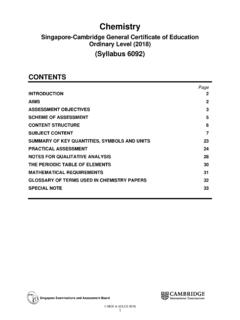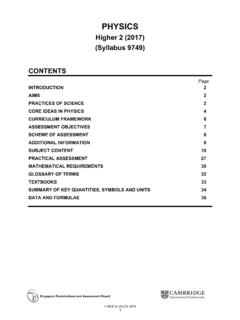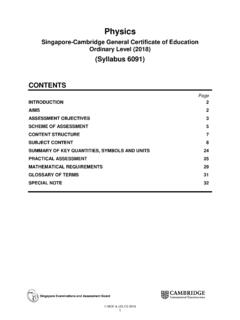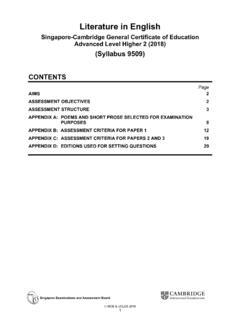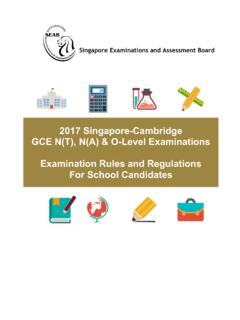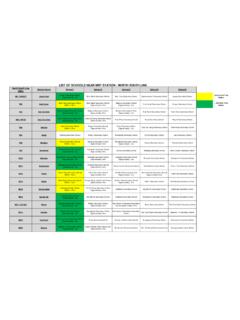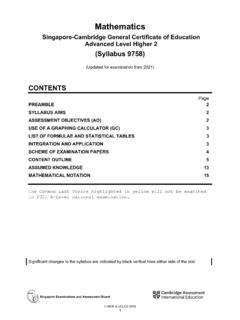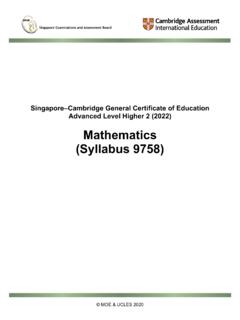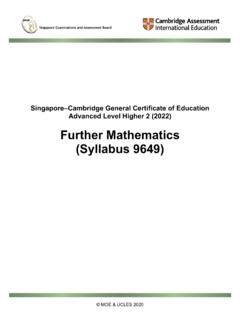Transcription of 6092 y21 sy - SEAB
1 chemistry Singapore-Cambridge General Certificate of Education Ordinary Level (2021). (Syllabus 6092). CONTENTS. Page INTRODUCTION 2. AIMS 2. ASSESSMENT OBJECTIVES 3. SCHEME OF ASSESSMENT 5. CONTENT STRUCTURE 6. SUBJECT CONTENT 7. SUMMARY OF KEY QUANTITIES, SYMBOLS AND UNITS 23. PRACTICAL ASSESSMENT 24. NOTES FOR QUALITATIVE ANALYSIS 28. THE PERIODIC TABLE OF ELEMENTS 30. MATHEMATICAL REQUIREMENTS 31. GLOSSARY OF TERMS USED IN chemistry PAPERS 32. SPECIAL NOTE 33. The Common Last Topics highlighted in yellow will not be examined in 2021 O-Level national examination. Singapore Examinations and Assessment Board MOE & UCLES 2019. 1. 6092 chemistry GCE ORDINARY LEVEL SYLLABUS (2021).
2 INTRODUCTION. This syllabus is designed to place less emphasis on factual materials and greater emphasis on the understanding and application of scientific concepts and principles. This approach has been adapted in recognition of the need for students to develop skills that will be of long term value in an increasingly technological world rather than focusing on large quantities of factual materials, which may have only short term relevance. It is important that, throughout the course, attention should be drawn to: (i) the finite life of the world's resources and hence the need for recycling and conservation (ii) economic considerations in the chemical industry, such as the availability and cost of raw materials and energy (iii) the social, environmental, health and safety issues relating to the chemical industry (iv) the importance of chemicals in industry and in everyday life.
3 It is envisaged that teaching and learning programmes based on this syllabus will feature a wide variety of learning experiences designed to promote acquisition of expertise and understanding. Teachers are encouraged to use a combination of appropriate strategies including developing appropriate practical work for their students to facilitate a greater understanding of the subject. AIMS. These are not listed in order of priority. The aims are to: 1. provide, through well-designed studies of experimental and practical chemistry , a worthwhile educational experience for all students, whether or not they go on to study science beyond this level and, in particular, to enable them to acquire sufficient understanding and knowledge to become confident citizens in a technological world, able to take or develop an informed interest in matters of scientific importance recognise the usefulness, and limitations, of scientific methods and models and to appreciate their applicability in other disciplines and in everyday life be suitably prepared for studies beyond Ordinary Level in chemistry .
4 In applied sciences or in science-related courses. 2. develop abilities and skills that are relevant to the study and practice of science are useful in everyday life encourage efficient and safe practice encourage effective communication. 2. 6092 chemistry GCE ORDINARY LEVEL SYLLABUS (2021). 3. develop attitudes relevant to science such as accuracy and precision objectivity integrity inquiry initiative inventiveness. 4. stimulate interest in and care for the local and global environment. 5. promote an awareness that the study and practice of science are co-operative and cumulative activities, and are subject to social, economic, technological, ethical and cultural influences and limitations the applications of science may be both beneficial and detrimental to the individual, the community and the environment science transcends national boundaries and that the language of science, correctly and rigorously applied, is universal the use of information technology is important for communications, as an aid to experiments and as a tool for interpretation of experimental and theoretical results.
5 ASSESSMENT OBJECTIVES. A Knowledge with Understanding Candidates should be able to demonstrate knowledge and understanding in relation to: 1. scientific phenomena, facts, laws, definitions, concepts, theories 2. scientific vocabulary, terminology, conventions (including symbols, quantities and units contained in Signs, Symbols and Systematics 16 19', Association for Science Education, 2000). 3. scientific instruments and apparatus, including techniques of operation and aspects of safety 4. scientific quantities and their determination 5. scientific and technological applications with their social, economic and environmental implications. The subject content defines the factual knowledge that candidates may be required to recall and explain.
6 Questions testing those objectives will often begin with one of the following words: define, state, describe, explain or outline (see the Glossary of Terms). 3. 6092 chemistry GCE ORDINARY LEVEL SYLLABUS (2021). B Handling Information and Solving Problems Candidates should be able (in words or by using symbolic, graphical and numerical forms of presentation) to: 1. locate, select, organise and present information from a variety of sources 2. translate information from one form to another 3. manipulate numerical and other data 4. use information to identify patterns, report trends and draw inferences 5. present reasoned explanations for phenomena, patterns and relationships 6.
7 Make predictions and propose hypotheses 7. solve problems. These assessment objectives cannot be precisely specified in the subject content because questions testing these objectives may be based on information which is unfamiliar to the candidates. In answering such questions, candidates are required to use principles and concepts that are within the syllabus and apply them in a logical, reasoned or deductive manner to a novel situation. Questions testing these objectives will often begin with one of the following words: predict, deduce, suggest, calculate or determine (see the Glossary of Terms). C Experimental Skills and Investigations Candidates should be able to: 1.
8 Follow a sequence of instructions 2. use techniques, apparatus and materials 3. make and record observations, measurements and estimates 4. interpret and evaluate observations and experimental results 5. plan investigations, select techniques, apparatus and materials 6. evaluate methods and suggest possible improvements. Weighting of Assessment Objectives Theory Papers (Papers 1 and 2). A Knowledge with Understanding, approximately 45% of the marks with approximately 15% allocated to recall. B Handling Information and Solving Problems, approximately 55% of the marks. Practical Assessment (Paper 3). Paper 3 will assess appropriate aspects of assessment objectives C1 to C6 in the following skill areas: Planning (P).
9 Manipulation, measurement and observation (MMO). Presentation of data and observations (PDO). Analysis, conclusions and evaluation (ACE). The assessment of Planning (P) will have a weighting of 15%. The assessment of skill areas MMO, PDO and ACE will have a weighting of 85%. 4. 6092 chemistry GCE ORDINARY LEVEL SYLLABUS (2021). SCHEME OF ASSESSMENT. Candidates are required to enter for Papers 1, 2 and 3. Paper Type of Paper Duration Marks Weighting 1 Multiple Choice 1h 40 30%. 2 Structured and Free Response 1 h 45 min 80 50%. 3 Practical 1 hr 50 min 40 20%. Theory Papers Paper 1 (1 h, 40 marks). This paper consists of 40 compulsory multiple choice items. A copy of the Periodic Table of Elements will be printed as part of this Paper.
10 Paper 2 (1 h 45 min, 80 marks). This paper consists of two sections. Section A will carry 50 marks and consists of a variable number of compulsory structured questions. Section B will carry 30 marks and consists of three questions. The first two questions are compulsory questions, one of which will be a data-based question requiring candidates to interpret, evaluate or solve problems using a stem of information. This question will carry 8 12 marks. The last question will be presented in an either/or form and will carry 10 marks. A copy of the Periodic Table of Elements will be printed as part of this Paper. Practical Assessment Paper 3 (1h 50 min, 40 marks). This paper consists of a variable number of compulsory practical questions.
